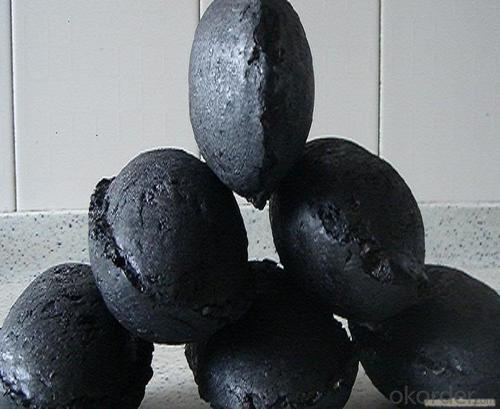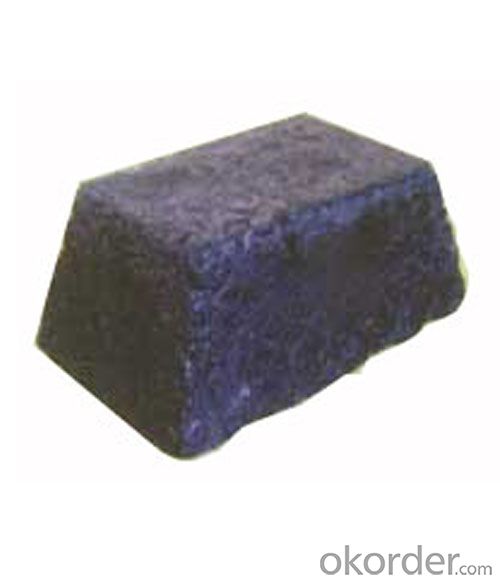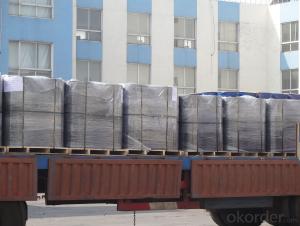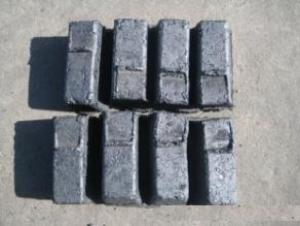Carbon Electrode Paste /Low Ash Ball CNBM
- Loading Port:
- Tianjin
- Payment Terms:
- TT OR LC
- Min Order Qty:
- 0 m.t.
- Supply Capability:
- 100000 m.t./month
OKorder Service Pledge
OKorder Financial Service
You Might Also Like
Product Description
Carbon Electrode Paste is a self-baking electrode used in submerged arc furnaces for delivering power to the charge mix. Electrode Paste is added to the top of the electrode column in either cylindrical or briquette form. As the paste moves down the electrode column the temperature increase causes the paste to melt and subsequently bake forming a block of electrically conductive carbon. Electrode Paste is essentially a mix of Electrically Calcined Anthracite (ECA) or Calcined Petroleum Coke (CPC) with Coal Tar Pitch.
Features
1:carbon eletrode paste
2:for ferroalloy,calcium carbide manufacture
3:HS 3801300000,YB/T5212-1996,ISO9001:2008
Product Description
Carbon Electrode Paste is a self-baking electrode used in submerged arc furnaces for delivering power to the charge mix. Electrode Paste is added to the top of the electrode column in either cylindrical or briquette form. As the paste moves down the electrode column the temperature increase causes the paste to melt and subsequently bake forming a block of electrically conductive carbon. Electrode Paste is essentially a mix of Electrically Calcined Anthracite (ECA) or Calcined Petroleum Coke (CPC) with Coal Tar Pitch.
Specification
Specification/Item |
|
|
|
|
|
|
Ash | 4.0%max | 5.0%max | 6.0%max | 7.0% Max | 9.0% Max | 11.0% Max |
VM | 12.0%-15.5% | 12.0%-15.5% | 12.0%-15.5% | 9.5.0%-13.5% | 11.5%-15.5% | 11.5%-15.5% |
Compress Strength | 18.0Mpa Min | 17.0Mpa Min | 15.7Mpa Min | 19.6Mpa Min | 19.6Mpa Min | 19.6Mpa Min |
Specific Resistance | 65μΩm Max | 68μΩm Max | 75μΩm Max | 80μΩm Max | 90μΩm Max | 90μΩm Max |
Bulk Density | 1.38G/CM3 Min | 1.38G/CM3 Min | 1.38G/CM3 Min | 1.38G/CM3 Min | 1.38G/CM3 Min | 1.38G/CM3 Min |
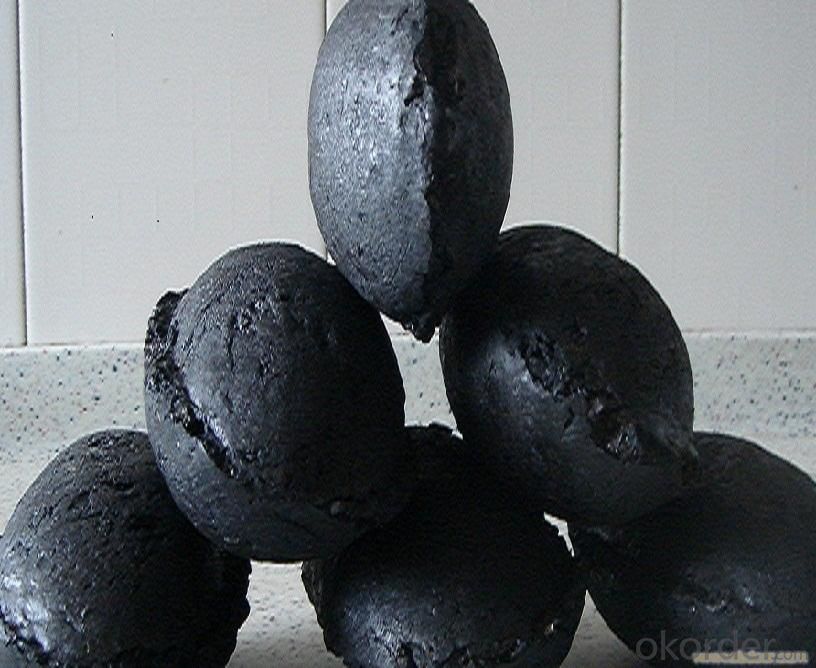
- Q: What are the effects of carbon emissions on the stability of volcanic regions?
- The stability of volcanic regions can be influenced by both direct and indirect effects of carbon emissions. At first glance, the direct impact of carbon emissions on volcanic areas seems relatively insignificant. Volcanic eruptions naturally release carbon dioxide (CO2), so the additional emissions from human activities may not have a significant individual effect on the stability of volcanic regions. However, the increased levels of carbon dioxide in the atmosphere can contribute to climate change, which can indirectly affect volcanic activity. Indirectly, the stability of volcanic regions can be affected by climate change resulting from carbon emissions. The rising global temperatures caused by climate change can lead to the melting of glaciers and ice caps. This, in turn, increases the amount of water on the Earth's surface. The additional weight of water in volcanic areas can potentially add pressure to magma chambers and trigger volcanic activity. Moreover, the increased water levels can result in higher levels of rainfall, which increases the risk of landslides and erosion in volcanic regions, potentially destabilizing the area. Additionally, climate change can alter precipitation patterns and create drought conditions, impacting the hydrological cycle. These changes can affect the availability of water for volcanic regions, ultimately influencing their stability. Volcanoes require water for the production of steam and pressure that can lead to eruptions. If there is a lack of water due to prolonged drought conditions, volcanic activity may decrease. However, unpredictable rainfall patterns can result in an excess of water, leading to an increased risk of flash floods and landslides that can destabilize volcanic areas. It is important to acknowledge that the effects of carbon emissions on the stability of volcanic regions are intricate and can vary based on factors such as local geology, volcanic activity, and climate conditions. Although carbon emissions may not directly cause volcanic eruptions, they can contribute to changes in climate patterns that can indirectly impact the stability of volcanic systems. Further research and monitoring are necessary to fully comprehend and quantify these effects.
- Q: What are the impacts of carbon emissions on coral reefs?
- Coral reefs are significantly affected by carbon emissions, with one of the most notable consequences being ocean acidification. This occurs when excess carbon dioxide (CO2) from the atmosphere is absorbed, causing the ocean to become more acidic. As a result, coral reefs struggle to build and maintain their calcium carbonate skeletons, which are crucial for their structure and survival. Consequently, their growth rates decrease, and their resilience weakens, making them more susceptible to damage from storms, disease, and other stressors. Moreover, the increasing ocean temperatures caused by carbon emissions have led to widespread events of coral bleaching. When corals are exposed to prolonged high temperatures, they expel the symbiotic algae (zooxanthellae) that live within their tissues. These algae provide essential nutrients and vibrant colors to the corals. Without them, corals become pale or completely white, a phenomenon known as bleaching. While corals can recover if the stressors decrease, severe or prolonged bleaching can result in coral death and the subsequent degradation of the reef ecosystem. Additionally, carbon emissions contribute to the intensification of storms and other extreme weather events, posing a direct threat to coral reefs. Stronger storms physically damage the reefs, breaking their fragile structures and reducing their resilience. Moreover, the sediment runoff from land, often exacerbated by storms, smothers corals and hinders their ability to feed and grow. The impacts of carbon emissions on coral reefs are not only detrimental to the diverse marine ecosystems but also to the millions of people who rely on them for food, income, and coastal protection. Coral reefs support a wide range of marine life, provide livelihoods for many communities through fishing and tourism, and act as natural barriers against storm surge and coastal erosion. The degradation of coral reefs due to carbon emissions jeopardizes the livelihoods and well-being of these communities, as well as the overall health and biodiversity of our oceans. To address these impacts, it is crucial to reduce carbon emissions by transitioning to cleaner, renewable energy sources, promoting sustainable practices on land to minimize runoff and pollution, and implementing effective management and conservation measures to protect and restore coral reef ecosystems.
- Q: Can barbecue carbon still have the effect of absorbing formaldehyde?
- Yes, there is also a role in the adsorption of formaldehyde in a variety of ways, the following provides 3 commonly used way:1) plants, yelan, Monstera can remove harmful substances in the air, tiger and Chlorophytum Chlorophytum can absorb more than 20% of indoor formaldehyde and other harmful gases; aloe is to absorb formaldehyde players, Milan, etc. wintersweet can effectively remove sulfur dioxide in the air, carbon monoxide and other harmful substances; orchid, osmanthus, Lamei etc. plant cilia to retain and adsorption particles floating in the air and soot.Ivy, cycads can effectively absorb indoor benzene, Chlorophytum can "devour" indoor formaldehyde and hydrogen peroxide, Arisaema also can absorb 40% of benzene, 50% tce. The volatile oils in flowers, such as roses, Osmanthus fragrans, violet, jasmine and carnation also have significant bactericidal effects.
- Q: What are the impacts of carbon emissions on the stability of coastal areas?
- Carbon emissions have significant impacts on the stability of coastal areas, posing various challenges to the environment and communities residing in these regions. One of the most prominent impacts is sea-level rise, caused by the melting of polar ice caps and thermal expansion of seawater due to rising global temperatures. As carbon dioxide and other greenhouse gases accumulate in the atmosphere, they trap heat, leading to the warming of the planet. This, in turn, causes glaciers and ice sheets to melt, contributing to the rising sea levels. Sea-level rise poses a direct threat to coastal areas, resulting in increased erosion, coastal flooding, and the loss of valuable land. As water levels rise, the shoreline retreats, eroding beaches and cliffs, and endangering coastal infrastructure and habitats. This erosion not only threatens the stability of coastal ecosystems but also puts human settlements at risk, leading to the displacement of communities and loss of property. Moreover, the increase in carbon emissions leads to ocean acidification, whereby the excess carbon dioxide is absorbed by the ocean, resulting in a decrease in its pH levels. Acidic waters have detrimental effects on marine life, including coral reefs, shellfish, and other marine organisms that rely on calcium carbonate for their shells and skeletons. As the acidity of the ocean increases, these organisms struggle to form and maintain their protective structures, leading to the degradation of coastal ecosystems and the loss of biodiversity. Another impact of carbon emissions on coastal areas is the intensification of extreme weather events, such as hurricanes and tropical storms. Warmer ocean temperatures provide more energy for these storms, making them more powerful and destructive. These events can cause extensive damage to coastal infrastructure, including buildings, roads, and utility systems. Furthermore, they can result in the loss of lives and livelihoods, exacerbating the vulnerability of coastal communities. In summary, carbon emissions have far-reaching impacts on the stability of coastal areas. Sea-level rise, ocean acidification, and intensified extreme weather events all contribute to the degradation of coastal ecosystems, loss of biodiversity, erosion, and coastal flooding. These impacts not only threaten the environment but also pose significant risks to human settlements, requiring urgent mitigation and adaptation measures to protect coastal areas and the communities that rely on them.
- Q: Emerald garden high carbon tempered metal
- The middle gate's most advanced war puppet! 3 o'clock, 9 o'clock position.Black dealers are also available
- Q: Isotopes of carbon
- There are three kinds of nature of carbon isotope, stable isotopes of 12C, 13C and 14C 14C of the radioactive isotope, the half-life is 5730 years, the application of 14C mainly has two aspects: one is the determination of biological death in archaeology, radioactive dating method; the two is labeled with 14C compound as a tracer, exploration the micro motion of chemistry and life science.
- Q: What is carbon black filler?
- Carbon black filler is a type of material made from fine particles of carbon that is added to various products, such as rubber, plastics, and inks, to improve their strength, durability, and color.
- Q: What is carbon footprint labeling?
- Carbon footprint labeling is a system that provides information about the amount of greenhouse gas emissions produced during the manufacturing, transportation, and use of a product. It aims to inform consumers about the environmental impact of their purchases, allowing them to make more sustainable choices and reduce their carbon footprint.
- Q: How does carbon dioxide affect the health of marine organisms?
- Carbon dioxide can have significant impacts on the health of marine organisms. When carbon dioxide is absorbed by seawater, it undergoes a chemical reaction that causes the water to become more acidic. This process is known as ocean acidification. Ocean acidification interferes with the ability of many marine organisms to build and maintain their shells and skeletons. For instance, corals, oysters, and other shellfish rely on calcium carbonate to form their protective structures. However, under more acidic conditions, the availability of carbonate ions decreases, making it harder for these organisms to calcify. This can lead to weakened shells, reduced growth rates, and increased vulnerability to predation and disease. Furthermore, ocean acidification can also disrupt the reproductive and developmental processes of marine organisms. For example, some studies have shown that increased CO2 levels can affect the ability of fish to locate their preferred habitats, find mates, and successfully reproduce. Additionally, some species of fish and invertebrates have been found to exhibit altered behavior and impaired sensory functions under high CO2 conditions. In addition to these direct effects, ocean acidification can also have indirect consequences for marine organisms by disrupting entire ecosystems. For instance, the decline in coral reefs due to reduced calcification can have cascading effects on the whole reef ecosystem, impacting the biodiversity and productivity of these important marine habitats. Overall, the increasing levels of carbon dioxide in the atmosphere are not only contributing to global climate change but also leading to ocean acidification, which poses significant threats to the health and survival of many marine organisms. It is crucial to address and mitigate the causes of carbon dioxide emissions in order to protect the delicate balance of our oceans and the diverse range of species that depend on them for their survival.
- Q: How does carbon dioxide affect the Earth's climate?
- The Earth's climate is significantly affected by carbon dioxide (CO2), a greenhouse gas. When released into the atmosphere through natural and human activities like deforestation, burning fossil fuels, and industrial processes, carbon dioxide traps heat from the sun and prevents it from escaping into space. This process is commonly referred to as the greenhouse effect. The accumulation of carbon dioxide in the atmosphere leads to a rise in global temperatures, resulting in climate change. As CO2 levels increase, more heat gets trapped, causing the Earth's average temperature to rise over time. This phenomenon is known as global warming. The consequences of increased carbon dioxide levels and subsequent climate change are extensive. Rising temperatures cause glaciers and polar ice caps to melt, contributing to a rise in sea levels. This can lead to coastal flooding, displacement of communities, and loss of biodiversity. Moreover, altered weather patterns, including more frequent and intense heatwaves, droughts, and extreme weather events like hurricanes and storms, are also associated with increased carbon dioxide levels. These events can have devastating impacts on ecosystems, agriculture, and human settlements. Furthermore, elevated CO2 levels also impact the chemistry of the oceans, making them more acidic through a process called ocean acidification. This poses a threat to marine life, especially organisms with calcium carbonate shells, such as corals and shellfish. To mitigate the impacts of carbon dioxide on the Earth's climate, it is crucial to reduce greenhouse gas emissions. This can be accomplished by transitioning to renewable energy sources, improving energy efficiency, promoting sustainable land use practices, and adopting cleaner technologies. Additionally, initiatives like afforestation and reforestation can help absorb CO2 from the atmosphere, acting as carbon sinks. Taking action to address the issue of carbon dioxide and its impact on the Earth's climate is vital to protect the planet's ecosystems, biodiversity, and human societies. By reducing carbon emissions, we can lessen the effects of climate change and work towards a more sustainable future.
Send your message to us
Carbon Electrode Paste /Low Ash Ball CNBM
- Loading Port:
- Tianjin
- Payment Terms:
- TT OR LC
- Min Order Qty:
- 0 m.t.
- Supply Capability:
- 100000 m.t./month
OKorder Service Pledge
OKorder Financial Service
Similar products
Hot products
Hot Searches


